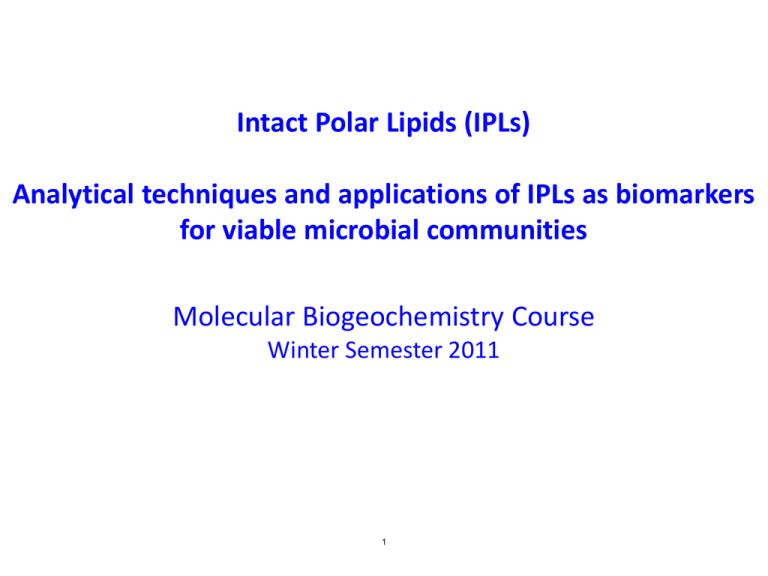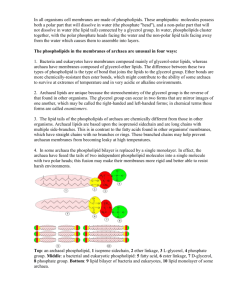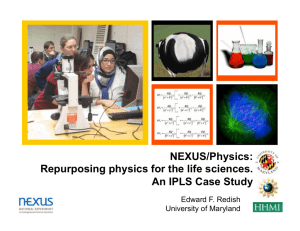
Intact Polar Lipids (IPLs)
Analytical techniques and applications of IPLs as biomarkers for viable microbial communities
Molecular Biogeochemistry Course
Winter Semester 2011
1
Structural diversity of intact polar lipids (IPLs)
2
Phospholipid biosynthetic pathways
• The archaeal and bacterial lipid synthesis is fundamentally different in terms of stereochemistry.
• The head group in bacteria is attached at sn‐3 of the glycerol
• The head group in archaea is attached at sn‐1 of the glycerol
• The pathways in archaeal lipid biosynthesis are not yet all eluciated.
• Cytidine diphospho (CDP)diacylgylcerol is the precursor of all phospholipids (with the exception of PC) in bacteria. In Archaea it is CDP archaeol.
PA ‐ phosphatidic acid
PE ‐ phospatidyl ethanolamine
PG ‐ phospatidyl glyerol
PC ‐ phospatidyl choline
PS ‐ phospatidyl serine
PI ‐ phospatidyl inositol
Daiyasu et al., 2005
Chemotaxonomic specificy of IPLs
Archaeal
diakylglycerol / isoprenoids
Bacterial (eukaryotic)
Morris Kates
Langworthy
Goldfine
DeRosa
diacylglycerol / fatty acids
Algae / Cyanobacteria
Marine crenarchaeota
Methanotrophs
Sulfate-reducing bacteria
Methanogens
Planctomycetes
4
Diversity of archaeal IPLs in methanogen cultures
5
Lipid based tree of life
6
distance
Using polar lipids to study microbial communities in the environment:
PLFAs (phospho-/polar lipid fatty acids) – the traditional approach
Oecologia (berl.) 40, 51-62 (1979)
Oecologia
© by Springer-Verlag 1979
Determination of teh Sedimentary Microbial Biomass
by Extractible Lipid Phosphate
1
D. C. White , W. M. Davis, J. S. Nickels, J. D. King and R. J. Bobbie
Department of Biological Science, Florida State University, Tallahassee, Florida 32306, USA
• Seminal paper showing that
phospholipids degrade rapidly upon
cell death.
• Phospholipid decay was analyzed
via the release of 32P phosphate
(which was added initially to build
up phospholipids).
• For many years PLFAs were
successfully applied as biomarkers
for viable organisms in
environmental studies.
• No methods developed yet to
readily analyze the intact molecule.
7
Analysis of IPLs by thin layer chromatography (TLC)
Silica gel plates
A
B
C
‐ Chloroform:methanol:water
(25:10:1 ; v/v)
‐ Chloroform:methanol:acetic acid water
(25:15:4:2 ; v/v)
Skipski et al., 1964
‐ diisobutyl:ketone‐acetic acid:water
(40:25:3:7 ; v/v)
Nichols et al., 1963
Until the establishment of HPLC‐MS this method was applied for a variety of bacterial
and archaeal cultures but not for analysis of environmental samples.
Shortcomings: Time consuming
no direct structural information
high background signal for soil/sediment samples
Slide: Julius Lipp
Advance in analytical techniques: from PLFAs to IPLs
Journal of Microbiological Methods 33 (1998) 23-35
Journal
of
Microbiological
Methods
Structural determination and quantitative analysis of bacterial
Phospholipids using liquid chromatography/electrospray ionization/
mass spectrometry
Allowed for rapid screening of
environmental samples for
bacterial phospholipids.
Jaisong Fang*, Michael J. Barcelona
Department of Civil and Environmental Engineering, The University of Michigan, 1213 IST Bldg., 2200 Bonisteel Blvd., Ann Arbor,
MI 48109, USA
Received 24 November 1997; received in revised form 13 March 1998; accepted 15 March 1998
RAPID COMMUNICATIONS IN MASS SPECTROMETRY
Rapid Commun. Mass Spectrom. 2004; 18: 617-628
Published online in Wiley InterScience (www.interscience.wiley.com). DOI: 10.1002/rcm.1378
Extended the method to the
analysis of archaeal lipids.
All three domains of life in one
analytical window!
Intact polar mambrane lipids in prokaryotes and
sediments deciphered by high-performance liquid
chromatography/electrospray ionization multistage
mass spectrometry-new biomakers for biogeochemistry
and microbial ecology.
1
Helen F. Sturt , Roger E. Summons2, Kristin Smith1 , Marcus Elvert 3
And Kai-Uwe Hinrichs1,3*
1
Woods Hole Oceonographic Institution, Department of Geology and geophysics, Woods Hole, MA 02543, USA
Massachusetts Institute of Technology, Department of Earth and Planetary Sciences, Cambridge, MA, USA
3
DFG Research Center Ocean Margins, Organic Geochemistry Group, University of Bremen, 28334 Bremen, Germany
9
2
Received 27 October 2003; Revised 3 December 2003; Accepted 8 December 2003
Advantage of combining PLFA + head group information
2UJDQLF*HRFKHPLVWU\
Organic
Geochemistry
A direct comparision between fatty acid analysis and intact
phospholipid profiling for microbial identification
Jaisong fang a,*, Michael J . Barcelona a, Pedro J.J. Alvarez b
a
b
Department of Civil and Environmental Engineering. The university of Michigan, Ann Arbor, MI 48109-2099, USA
Department of Civil and Environmental Engineering. The university of Iowa, Iowa City, IA 52242-15272, USA
Received 25 October 1999; accepted 5 April 2000
(returned to author for revision 21 December 1999)
• Study of cultures
(5 Pseudomonas strains)
• Combining the information of PLFA
analysis with the head group type
provides a more detailed information
than just the PLFA analyses
10
IPLs
Analytical Techniques
11
Relative applicability of GC/MS vs. LC/MS
MW
100000
Electrospray (ESI)
10000
1000
GC/MS
Atmospheric Pressure
Chemical Ionization (APCI)
Nonpolar
Very polar
Analyte polarity
Image by MIT OpenCourseWare.
12
Slide: Ellen Hopman
Instrument Design: GC/MS vs. LC/MS
GC/MS
Sector, Quadrupole, TOF
EI, CI
Sample
Introduction
Interface to
Vacuum
Ion Source
Mass
Analyzer
Detector
High Vacuum
LC/MS
(triple) Quadrupole, ion trap, TOF, sector
ESI, APCI, APPI
Sample
Introduction
Ion Source
Interface to
Vacuum
Mass
Analyzer
Detector
High Vacuum
Atmospheric Pressure Ionization (API)
Image by MIT OpenCourseWare.
13
Slide: Ellen Hopmans
IPL Analysis: HPLC Separation
Phase for separation:
Normal phase diol column, 150 x 2.1 mm�
(Reversed phase also possible)
A
B
Sample
injector
Gradient
mixer
Column oven
Pump
Column
Autosampler
Pressure: 20-100 bar
Detector
Eluent flow rate: 0.2 ml/min
Gradient elution: 0% B to 65% in 45 min
Chromatogram
Eluents:
(A): 79% Hexane, 20% Isopropanol
(B): 89% Isopropanol, 10% Water
both include Ammonium formate buffer
Polarity
14
Slide: Julius Lipp
Image by MIT OpenCourseWare.
Electrospray Ionization (ESI)
http://penyfan.ugent.be/labo/joelv/Esquire.html
• High electric field (3-5 kV/cm) produces a fine mist of highly charged droplets
• Ion evaporation process produces analyte ions (Coulomb explosion: the
magnitude of the charge is sufficient to overcome the surface tension holding
the droplet together)
Positive species formed: [M+H]+, [M+NH4]+, [M+Na]+
Negative species formed: [M-H]-, [M+HCOO]-, [M+OAc]­
15
M. Yamashita and J. B. Fenn, J. Phys. Chem., 88, 4451-4459 (1984)
Kebarle and Tang, Aral. Chem., 65, 2, 972A-985A (1993)
Compound detection: Single quadrupole mass spectrometry
• DC (direct current) and Rf (radio frequency)
voltages are applied to the rods creating an
electrical field in which the ions oscillate.
• As Rf and DC voltages are ramped up, ions of
successively higher m/z have a stable trajectory
and are allowed to pass.
Single Quad: Gives only information on molecular
mass and intensity, but with high sensitivity in
SIM (selected ion monitoring) mode. No structural
information!
16
Single Quad analysis
17
Isobaric IPL molecules with m/z 706
C18/C15 PE-DAG
C16/C15 PDME-DAG
C17/C16 PE-DAG
C15/C15 PC-DAG
C16/C17 PE-DAG
C16/C15 PC-AEG
C16/C16 PME-DAG
18
Slide: Julius Lipp
• How can those isobaric molecules be
distinguished in the mass
spectrometer?
• MS1 information is not enough
• Retention time can help if there are
structural differences
Ion Trap mass spectrometry
• Isolation of ions of interest (e.g. 700 Da)
• Trapped ions can be fragmented by application of energy
• Fragments can be analyzed or isolated and fragmented again
• Higher order MSn is possible in this type of mass spectrometer, which
enables better structural elucidations.
19
MS analysis: data dependent mode
20
MS analysis: Ion trap MSn
21
Quadrupole Time-of-Flight mass spectrometry (QToF-MS)
22
Slide: Julius Lipp
Triple Quadrupole mass spectrometry
MRM and SRM possible = multiple and selected reaction monitoring. This method focuses
on one parent ion and it’s specific fragmentation. It is very good for quantification as it
entails a high sensitivity.
23
Mass spectrometric fragmentation pathways of IPLs
24
Slide: Julius Lipp
Typical phospholipid fragmentation pattern loss of head group 25
Glycolipid fragmentation pattern loss of head group/acyl side
26
Typical IPL fragmentation patterns
Common Reactions of Selected Phospholipids Under MS/MS Conditions in both Positive and Negative Ion Mode
Headgroup
Positive Ion Mode [M+H]+
AEG, DAG
Negative Ion Mode [M-H]-
DEG
AEG, DAG
DEG
PE
141 Da Loss
(Phosphoethanolamine)
43 Da Loss (Ethanolamine)
APT
231 Da Loss (Phospho-APT)
133 Da Loss (APT)
AEG-P; Loss of sn-2 fatty acid
133 Da Loss (APT)
PG
189 Da Loss (phosphoglycerol
+
+ NH4 adduct)
75 Da Loss (Glycerol)
DAG-P; Loss of head
group + sn-2 fatty acid
75 Da Loss (Glycerol)
PI
PS
PC
43 Da Loss (Ethanolamine)
Major ion m/z 241
(Phosphoglycosy1 -H2O)
162 Da Loss (Hexose)
185 Da Loss (Phosphoserine)
87 Da Loss (Serine)
87 Da Loss (Serine)
All give major Ion m/z 184 (Phosphocholine)
All show 60 Da Loss (CH3 + HCOO- adduct)
Sturt et al., 2004, RCM
Image by MIT OpenCourseWare.
Typically, two analyses are ideal: positive & negative ion mode
Complementary information that aid structural assignments
27
Problems of quantification: response factors & ion suppression
Ion suppression when working
with sediment extracts
Pronounced reduction of
response due to matrix effect
Problem for quantification!
Can be partly solved by adding
an internal or injection
standard to the samples
28
Slide: Julius Lipp
Injection of calibration mixture with multiple compounds
Different response for
different compounds
Ionization efficiency
29
Slide: Julius Lipp
Varying response factors of IPL compounds
30
IPLs
Application in environmental samples
31
PLFA / IPL application in the Wadden Sea
•
•
•
•
Ground-breaking application in environmental samples
PLFA and IPL seem to reflect same pool
IPLs decrease rapidly after 10cm
IPLs still present at deeper depth = reflects presence of
viable cells
• composition of IPLs: mainly PC, PG and other
phospholipids,
could be partly linked to SRBs
32
Application of IPLs in environmental samples
Organic
Geochemistry
Available online at www.sciencedirect.com
Organic Geochemistry 34 92003) 755-769
www.elsevier.com/locate/orggeochem
• Detection of phospholipids in
sediments up to depths of 799 m
• Alternative method to quantify
biomass to gene-based methods.
Intact phospholipids-microbial "life markers" in
marine deep subsurface sediments
Klaus-G. Zink a,b,*, Heinz Wilkesb, Ulrich Diskoa,
Marcus Elvertc, Brian Horsfield b
Institut für Erdöl and Organische Geochemie, Forschungszentrum Jülich GmbH, 52425 Jülich, Germany
GeoForschungsZentrum Potsdam, Sektion 4.3, Telegrafenberg, 14473 Potsdam, Germany
Institut für Marine Mikrobiologie, Department of Biogeochemistry, Celsiusstr, 1, 28359 Bremen, Germany
Received 22 July 2002; accepted 21 January 2003
(returned to author for revision 25 October 2002)
Contents lists available at ScienceDirect Organic Geochemistry •
Changes in IPL composition reflect
geochemical zonation
• The assignments to specific source
organisms is, however, not
straightforward
journal homepage: www.elsevier.com/locate/orggeochem Vertical distribution of microbial lipids and functional genes
In chemical distinct layers of a highly polluted meromictic lake
Tobias F. Ertefaia,*, Meredith C. Fisherb, Helen F. Fredricksd, Julius S. Lippa, Ann Pearsonc,
Daniel Birgela, Kai M. Uderte, Colleen M. Cavanaughb, Philip M. Gschwende, Kai-Uwe Hinricha
33
IPL composition follows water column stratification: Black Sea
34
Schubotz et al., EM (2009)
IPL composition follows water column stratification: Black Sea
Suboxic: anoxygenic phototrophs
Ammonium oxidizing crenarchaea
35
Schubotz et al., EM (2009)
IPL composition follows water column stratification: Black Sea
Anoxic: sulfate-reducing bacteria,
unknown anaerobic bacteria
36
Schubotz et al., EM (2009)
Archaeal IPLs in the Black Sea water column and sediments
37
Schubotz et al., EM (2009)
IPL analysis of the marine crenarchaea Nitrosopumilus maritimus
Vol. 74, No. 8
APPLIED AND ENVIRONMENTAL MICROBIOLOGY, Apr. 2008, p. 2433-2440
0099-2240/08/$08.00+0 doi: 10.1128/AEM.01709-07
Copyright © American Society for Microbiology. All Rights Reserved.
Intact Membrane Lipids of "Candidatus Nitrosopumilus maritimus," a
Cultivated Representative of the Cosmopolitan Mesophilic
Group I Crenarchaeota ∇
Stefan Schou ten , 1* Ellen C. Hopma ns, 1 Marian ne b as s, 1 Henry Boumann, 1 Sonja Stan dfest, 2
Martin Könn eke, 2 David A. Stah l,3 and Jaap S. Sinni nghe Damst é 1
IPLs
38
Biggest problem: Identifying biological sources for IPLs
IPLs have a limited level of chemotaxonomic specificy.
There is need for more IPL analysis in environmentally relevant cultures. For many of the IPL observed in the environment we don’t know who the
sources might be.
Solutions:
Always combine with DNA data if available. Geochemical parameters are also important.
Target very specific IPLs that are characteristic for only certain groups of
organisms (e.g. crenarchaeol, ladderane lipids/)
Combine the IPL analysis with stable isotope data to gain insights on the
metabolic activities of the organisms.
Investigate more environmentally relevant cultures.
39
Targeted IPL analysis – investigating specific biomarkers in the N cycle
The ISME Journal (2011), 1-9
© 2011 International Society for Microbiological Ecology All rights reserved 1751-7362/11
www.nature.com/ismej
archaea
u
ORIGINAL ARTICLE
Niche segregation of ammonia-oxidizing archaea
and anammox bacteria in the Arabian Sea oxygen
minimum zone
1,3
1
1,2
, Laura Villanueva
, Ellen c Hopmans , Stefan Schoutan
,
2
1,2
Gert-Jan Reichart and Jaap S Sinninghe Damsté
Angela Pitcher
1,3
bacteria
Marine
crenarchaea:
nitrification
Anammox
bacteria:
Anaerobic
oxidation of
ammonium
40
IPLs are not only community markers but also reflect the physiological state of the microbial community
Prochlorococcus 9312
„Phospholipid substitution are fundamental
biochemical mechanisms that allow
phytoplankton to maintain growth in the
face of phosphorous limitation.“
North Pacific Subtropical Gyre
Van Mooy et al., 2006 PNAS
• Heterotrophic bacteria do not have the ability to substitute for phospholipids
• Cynobacteria do not synthesize nitrogen
containing lipids, while eukaryotic
phytoplankton is „burdened“ with an extra nitrogen requirement during lipid
synthesis.
41
Van Mooy et al., 2009 Nature
IPLs from consortia that mediate the anaerobic oxidation of methane(AOM) 42
IPL distribution of AOM communities around the world
43
Which environmental factors control AOM consortia dominance?
44
Which Environmental Factors Control AOM Consortia Dominance?
ANME-1
ANME-2a/DSS
ANME-3/DBB
Archaeal IPLs
Gly-GDGTs
P-GDGTs
P-AR based IPLs
Gly-AR based
IPLs
P-AR based IPLs
Bacterial IPLs
Low
abundance
High abundance
(PC, PG, PE)
High abundance
(esp. PDME, PME)
Temperature
Medium
Low
Low
O2-conc. in
bottom waters
Low
(or anoxic)
High
High
Sulfate
Less
supply of
sulfate
Need of efficient
supply of sulfate
----------­
Image by MIT OpenCourseWare.
Rossel et al., GCA, 2011
45
Carbon flow tracked by stable isotopes δ13C
Fixation pathway
46
δ13C analysis at methane seep areas
47
ODP Leg 201: Deep sulfate-methane transition zones (SMTZ)
Reaction: CH4 + SO42- HCO3- + HS- + H2O
48
+ 13C-depleted biomass
ODP Leg 201: Archaea in deeply buried sulfate-methane interfaces
• Detection of archaeal tetraether and diether IPLs
• No bacterial lipids detected
Euryarchaea
South African Gold Mine Euryarchaeal Group-1
1227: 4 clones
Marine Group III (MG-III)
1229: 1 clone
Marine Benthic Group B
“MBG-B”
1227: 81 clones
1229: 1 clone
1230: 26 clones
• FISH probes Arch915
and Eub338 used
1229D-29.8
• Detection of
archaeal cells with
less than 0.5 µm in
diameter
Crenarchaea
“MCG”
1229: 56 clones
Image courtesy of National Academy of Sciences (PNAS). Used with permission
•16S rRNA: selecting for active Archaea
•No ANMEs detected, only Benthic Archaea
Probe Arch915, scale bar: 1 µm
Biddle, Lipp et al., PNAS (2006)
Miscellaneous Crenarchaeotal
Group
49
Archaea in deeply buried SMTZs: what is feeding them?
1229D 29.8
d
Probe Arch915, scale bar: 1 µm
Image courtesy of National Academy of Sciences (PNAS).
Used with permission
50
Image courtesy of National Academy of Sciences (PNAS).
Used with permission.
Biddle, Lipp et al., PNAS (2006)
SMTZ
MBG-B
SMTZ
MCG
1229
1227
ODP Leg 201: δ13C of sedimentary carbon pools
CH4
DIC
MBG-B
SMTZ
1230
TOC
-100
-80
-60
-20
-40
d13C (‰)
0
20
Biddle, Lipp et al. PNAS (2006)
51
IPL
FISH-SIMS
ODP Leg 201: δ13C of sedimentary carbon pools
CH4
CO2
Methane assimilation should be reflected in
CH
the isotopic signature
Archaeal cell
4
TOC
Archaea oxidize methane but do not assimilate its carbon
52
MIT OpenCourseWare
http://ocw.mit.edu
12.158 Molecular Biogeochemistry
Fall 2011
For information about citing these materials or our Terms of Use, visit: http://ocw.mit.edu/terms.
79








